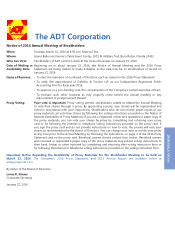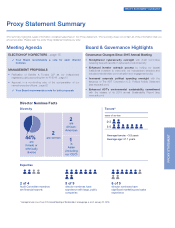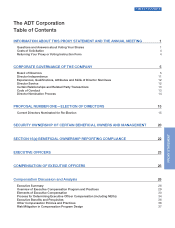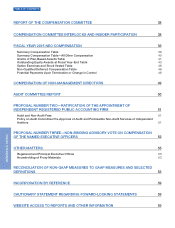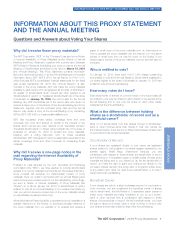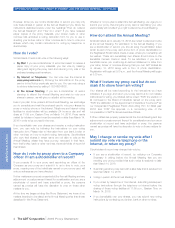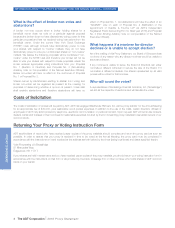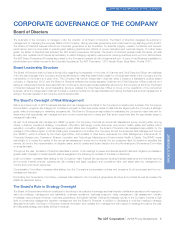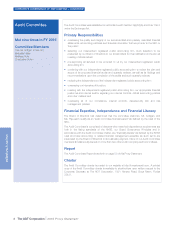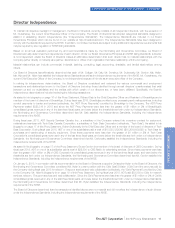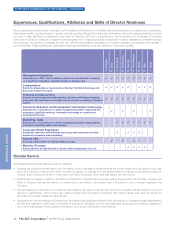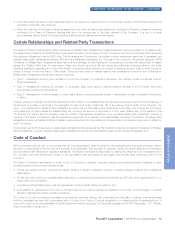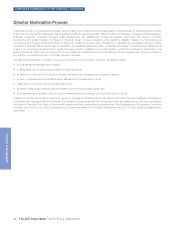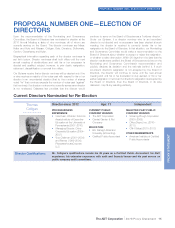ADT 2015 Annual Report Download - page 15
Download and view the complete annual report
Please find page 15 of the 2015 ADT annual report below. You can navigate through the pages in the report by either clicking on the pages listed below, or by using the keyword search tool below to find specific information within the annual report.
CORPORATE GOVERNANCE OF THE COMPANY
CORPORATE GOVERNANCE OF THE COMPANY
Board of Directors
The business of the Company is managed under the direction of its Board of Directors. The Board of Directors delegates its authority to
management for managing the everyday affairs of the Company. Strong corporate governance is and has been a long-standing priority at ADT.
The Board of Directors believes that sound corporate governance is the foundation for financial integrity, investor confidence and superior
performance, and it is committed to recruiting and retaining directors and officers of proven leadership and personal integrity. To further these
goals, the Board of Directors has adopted the ADT Board Governance Principles. The Board of Directors reviews these Principles, at least
annually, and updates the Principles as necessary to reflect changing regulatory requirements, evolving practices and input from stockholders.
The ADT Board Governance Principles are posted on the Company’s website at http://investors.adt.com. A copy of the Principles is available to
stockholders upon written request to the Corporate Secretary at The ADT Corporation, 1501 Yamato Road, Boca Raton, Florida 33431.
Board Leadership Structure
The Board of Directors does not have a formal policy regarding the separation of the roles of Chairman and Chief Executive Officer, as it believes
it is in the best interests of the Company and its stockholders to make that determination based on the business needs of the Company and the
membership of the Board at a given time. The Company has had an independent Chairman since it became a standalone publicly-traded
company in September 2012, and the Board of Directors believes that having separate Chairman and Chief Executive Officer positions, and
having an independent director serve as Chairman, continues to be the appropriate leadership structure for the Company at this time. The Board
of Directors believes that the current leadership structure enables the Chief Executive Officer to focus on the operations of the Company’s
business, while the independent Chairman focuses on leading the Board in its responsibilities and helping the Board ensure that management is
acting in the best interests of the Company and its stockholders.
The Board’s Oversight of Risk Management
Risk is an inherent part of ADT’s business activities and risk management is critical to the Company’s innovation and success. The Company’s
compensation programs are designed to motivate employees to take appropriate levels of risks that are aligned with the Company’s strategic
goals, without encouraging or rewarding excessive risk. The Board of Directors is responsible for evaluating the Company’s major risks and for
determining that appropriate risk management and control procedures are in place and that senior executives take the appropriate steps to
manage all major risks.
As part of its enterprise risk management (“ERM”) program, the Company conducts an annual risk assessment survey covering risks, among
others, in finance, operations, strategy, compliance, information technology, human resources, environment, health, safety and welfare, brand
reputation, innovation, litigation, risk management, public affairs and competition. The Board of Directors has delegated responsibility for the
oversight of the ERM program to its Nominating and Governance Committee. The Company formed the Enterprise Risk Management Council
(the “ERMC”), which is chaired by the Chief Legal Officer, and consists of other senior executives from Risk Management, Internal Audit, IT,
Corporate Development, Operations, Finance, Innovation and Technology, Marketing and Environmental, Health & Safety. The ERMC meets
periodically to (i) review the results of the annual risk assessment survey and to identify the top enterprise risks, (ii) determine specified risk
owners, (iii) monitor the implementation of mitigation plans, and (iv) update and obtain direction from the Nominating and Governance Committee
on a regular basis.
Throughout the year, the Board of Directors dedicates a portion of its meetings to review and discuss specific risks and mitigation processes in
greater detail. Oversight of certain specific risks is delegated to the following committees of the Board of Directors:
Audit Committee—oversees risks relating to the Company’s major financial risk exposures including financial statements and financial reporting
and controls, internal controls, cybersecurity risk oversight and legal, regulatory and compliance risks, and steps taken by management to
monitor and control such exposures.
Compensation Committee—oversees risks arising from the Company’s compensation policies and programs for all employees and the non-
management directors.
Nominating and Governance Committee—oversees risks related to the Company’s governance structure and process as well as oversee the
ERMC as described above.
The Board’s Role in Strategy Oversight
The Board of Directors as a whole is constituted to be strong in its collective knowledge and has diversity of skills and experience with respect to
vision and strategy, management and leadership, business operations, business judgment, crisis management, risk assessment, industry
knowledge, accounting and finance, corporate governance, and global markets. Setting the strategic course of the Company involves a high
level of constructive engagement between management and the Board of Directors. In addition to dedicating a multi-day meeting to strategy
discussions annually, the Board of Directors receives information and updates from management with respect to strategy throughout the year
and discusses strategy periodically at Board meetings.
The ADT Corporation 2016 Proxy Statement 5
PROXY STATEMENT


